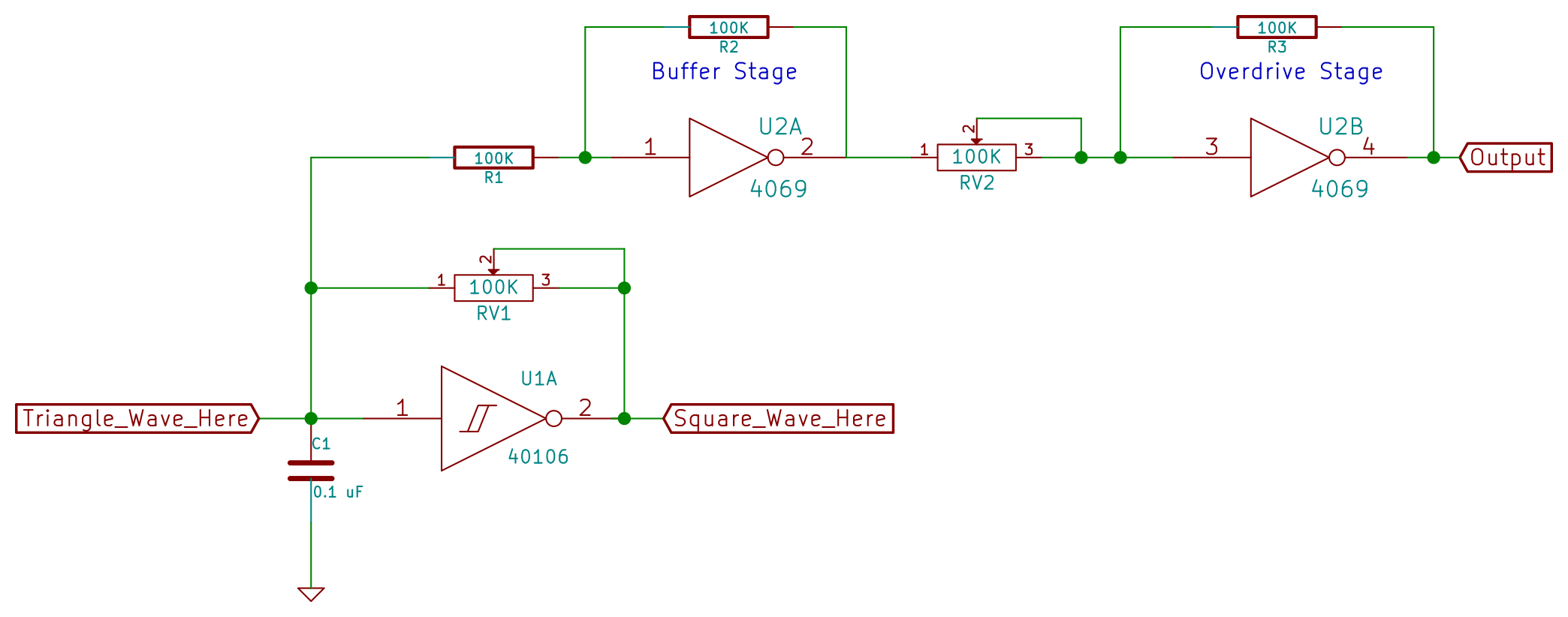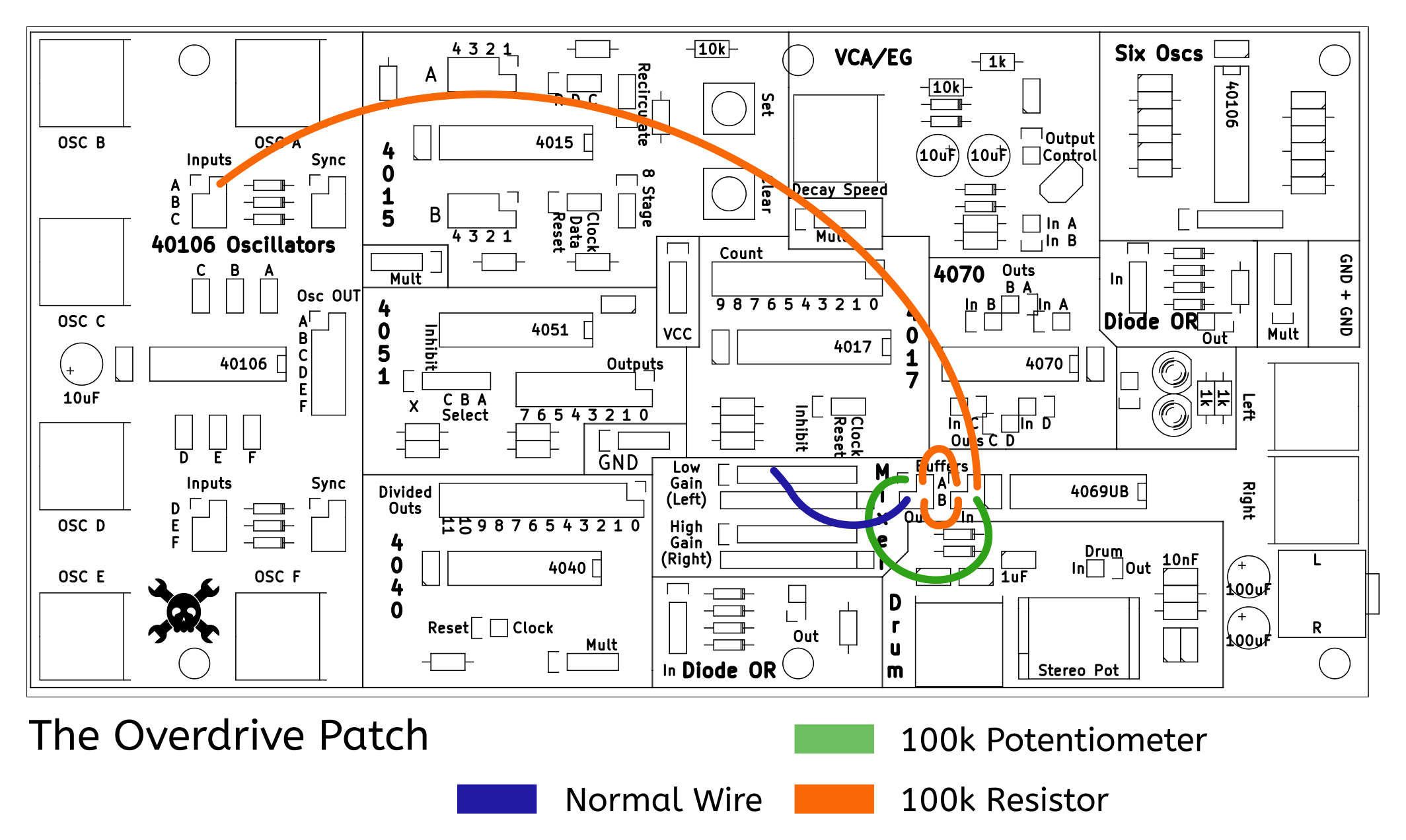Logic Noise: Klangorium
A Single-board Modular Logic Noise Synth Monster
A Single-board Modular Logic Noise Synth Monster
To make the experience fit your profile, pick a username and tell us what interests you.
We found and based on your interests.
Because of the way the Klangorium kit is built, it's a little bit difficult to get the overdriven triangle wave sound out of it, but because I love that sound so much, I'm going to show you how.
The regular triangle wave is easy-peasy. First off, just tap into the input and connect it to the high-gain mixer out. Done. On the breadboard, we needed an output-buffer stage, but here the output amplifier / active mixer serves the same purpose.
The overdrive effect relied on running our sound through a unity-gain buffer stage and then through another amplifier stage with enough gain to start distorting. The good news is that the Klangorium has two 4069UB inverter stages free. The bad news is that we're going to need some extra parts.

In particular, we'll need two 100k resistors for the first stage buffer, and a 100k pot and another 100k resistor for the overdrive section.
You can connect these into the circuit however you like, but I find it easiest to take two female-female cables and insert the resistor in the middle. You've effectively got a double-length cable with 100k ohm's resistance. Make three of these, and then do the same thing with the potentiometer.
Now, starting with the input terminal of an oscillator (where the triangle waves come out) connect it to the input of one of the buffers with the 100k ohm cable. Connect the output of that buffer to it's input with another 100k ohm cable.
Now using the potentiometer cable, connect the output of that first buffer to the input of a second. Using the last 100k ohm cable, connect the second buffer's input and output together. Finally, the output of that buffer should go to a low-gain mixer input.

And do note that a little overdrive can be tastefully applied anywhere. For instance, it's great with the drum voice.
Say you've got the board and parts in front of you. Congrats! Now put it together.
It's not hard, but it's got 550 solder joints. The good news is that none of them are particularly critical or difficult. If you're a beginner with the soldering iron, you'll be experienced by the time you're done. (Or you'll be driven stark-raving mad.) Even if you're a seasoned flux-wielding veteran, you'll need some patience.
I've built up a few of these now, and here's my advice.
First, put all the header pins in their respective holes.
Now get a piece of cardboard and put it on top of the pins before you (gently) flip it over. This way, you stand a chance of getting the pins aligned straight with the board upside-down.
Now solder in one pin from each header, to make it easy to adjust any that are screwy.
Only once you're content that they're all in straight, solder the headers in for real. It's a lot of soldering. Take a break when you're done.
If you've followed along with the Logic Noise series, you've noticed that I designed the sessions to build on the previous ones. Because the board is essentially modular, you can now do the same assembling it.
That is, build a section, explore it, learn it, internalize it, and then move on to the next section. Think of this as a pleasant stroll through the pastures of silicon synthesizer possibilities, rather than as a project you'd like to get done fast. It'll keep you sane.
Create an account to leave a comment. Already have an account? Log In.
Hi Elliot, I love this project. I'm planning to make a couple of boards ASAP.
I'm new to using remote fab services. To get a quote, I first need to tell Elecrow the dimensions of the board. I'm assuming 2-layer is the one to click for a double-sided PCB?
How long and wide is the finished circuit-board?
thanks,
Rod.
I would like to know the same. Whatever happened to the board?
It's still there, up on GitHub, and I have a few in my closet. See my response below, though.
TL;DR: I'd like to revisit it b/c two footprints fit odd parts and some of the other KiCAD components need updating.
ok just finished this board. The oscillators very faintly bleed through to the audio output when nothing is patched. its very annoying. although its a nice fat six osc chord Id prefer a clean pallet to build from. what can I add to stop this oscillator bleed?
As per a filter the drum section is an interesting sort of filter to tone down some of the oscillators harshness. but its also a really meaty drum. that decay good lord.
really enjoying this board though! very interesting mini modular!
as per lack of BOM.
I put 100nf in all the capacitor spots that werent labelled.
headers for the variable oscillator sections(the six pots on the left) right outside the chip/ (check the built images) should have headers so you can change the cap values. 100pf-10uf
100k resistor network x2. as its mentioned in one article that all the circuits should be summed with 100k. my network was one to long so i just snipped off the last pin on both of them. put the dot in the square outline etc.... (DONT SNIP OFF THE WRONG ONE!!!!!!)
100k linear for all the pots
the dual stereo i also put 100k linear.
100k resistors for all the unlabeled ones.
2n3904 for the vca (amp)- how the hell do I get an envelope shape lol.
the osc section in the top right I assume the idea is to leave it blank till you find some values you want to standardize and not change with a potentiometer. kinda like a master locked BPM using a resistor value(the potentiometer value you choose and measure or w/e) to fine tune that.
I mostly followed the pictures and found random usefull tidbits in the articles.
A bom would be beneficial though as I want to read the articles with a completed klangorium. oh well. havent watched the videos looking forward to going through all the articles with my klangorium in hand now.
not to difficult of a build gonna be alot of fun to play and patch with this on vacation! these chips seem so powerful! mini lunetta modular ftw! CMOS shennagins!
---------Aside-------
lots of great circuits on electro music forum that you can patch up on this device.
the only thing missing is many of the amazing lunetta drum circuits. 4022 dual drummer etc... check the em forum lunetta sub forum. id love another companion board to the klangorium with more of the crazy sequencing options and more of a drum focus with lots of those tiny dip switches.
and tons of leds.
anyhoo thanks for this amazing project!
i wonder if we could get some eurorack/modular integration going with this.
Holy cow! Great review.
Comments:
* The board needs a BOM, but most of the parts are self-explanatory. As you noted all resistors are 100k except as noted on the silk, all pots are 100k linear, except the 100k linear stereo pot in the drum, all decoupling caps are 0.1uF/100nF, and all other values are on the silk.
* BUT: the stereo jack and pot I used have (apparently) odd pinouts/footprints. If anyone has a suggestion for more common alternatives for either, I'm all ears.
* I looked at the KiCAD files just a few weeks ago. Some of the footprints are no longer included in modern KiCADs. I'll have to rework the files and bundle up all the parts.
* I'm still torn about the value of tossing all of this in one monolithic board vs breaking them all out into (say) 50 mm x 50 mm sub-boards. That's why I designed the KiCAD using hierarchical sheets -- you can break out any of the sub-circuits as easily as copying a file, but then you have to re-do layout. Anyway, I'm half inclined to do a more modular re-spin.
* The "cymbals" should come pre-routed instead of being left so modular: hooking up the "Six Oscs" + XOR + VCA involves a lot of wiring, and I really use it as cymbals most of the time. Thoughts?
Anyway, I'm re-visiting this board and the whole project right now, so I'd love to hear what people think! (Particularly on the "more modules" vs "monolithic" choice.)
Logic noise was a great series and this is a great project. I have ordered the PCBs but without BOM it's a bit tricky to start. I'm using the original articles as a reference but it would be great if you are able to provide us the BOM (or maybe a full schematic?) at some point. Great work anyway
where did you order the pcbs? I want to try to build this
I'm interested in this project. Should I etch my own PCB or wait for a PCB to go on sale?
Yeah! I totally dropped the ball on the BOM. I should really run back through it and do it.
I am so ready to buy this!! If it's not going to be a product, a BOM would be awesome
So was this ever made available? Where can I get it now?
Do you happen to have a BOM for this project? I'd like to purchase the parts needed in one fell swoop. Thx.
Are these for sale? i really like this project you've made!
I like this. I'm looking forward to the kit. It needs a second EG and a VCF, though. Anyone care to offer a good, simple design capable of self-oscillation over a good range? I borrowed the Mutable Instruments Anushri 12 db/oct design for my synth: https://github.com/quarterturn/squareinator/blob/master/squareinator2.pdf It has a low parts count, doesn't use any vintage chips, and works well but needs some further adjusting as the self-oscillation falls off on the lower octaves.
Become a member to follow this project and never miss any updates
By using our website and services, you expressly agree to the placement of our performance, functionality, and advertising cookies. Learn More
Hi Elliot, is there a parts list for this?